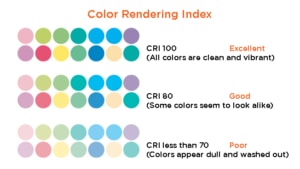Our white paper, VioLight- Improving Color in Real-Life Applications, brings
up an interesting new perspective on how to measure color in lighting.
It’s all about CRI, right? Well, sort of.
Some background: Daylight had been held as the benchmark for comparing colors – but there was growing interest to create an easier tool. The Color Rendering Index (CRI) metric is, by far, the most widely used in lighting for evaluating the ability of a light source to reveal colors. It was developed by the International Commission on Illumination (CIE) in 1961 as a way to assess the perceived color shift when comparing two light sources.

Basic breakdown: CRI compares how light sources reflect the top row of Munsell Color Chips R1-R8. If you were to shine a light source on the above chips and compare the colors to how they look lit by the reference source at the same color temperature and there were no change, then the CRI of the test light source would be 100. As the light changes, there is a fancy formula used to calculate what the difference is between the light source’s rendering ability and the reference source. Let’s not get bogged down with details.
While this has been the go-to metric for decades, there are a few tricky things to consider when relying on CRI as the only color evaluation metric:
· CRI is used to measure light sources at the same CCT. As we know, CCTs can range in light sources so this could be particularly difficult to accurately assess a light sources capability to render colors.
· CRI is only evaluating the first eight chips which are unsaturated colors.
· It is possible to target certain chips within R1-R8 with color “pumps” to artificially increase the CRI value without actually improving the overall color rendition of the entire source.
So what else can we use?
There is a competing metric, called the color quality scale or CQS, that has been in development by the National Institute of Standards and Technology (NIST). As stated in our white paper, the major advantage of CQS is that it takes into account a total of 15 color samples of more saturated colors (and does not poorly represent red, as is found in CRI). This means that color pumping methods won’t work as well and colors can be more vividly represented.
While in the works, it should be noted that CIE Technical Committee 1-69 has not recognized the CQS as a replacement for the CRI scale.
